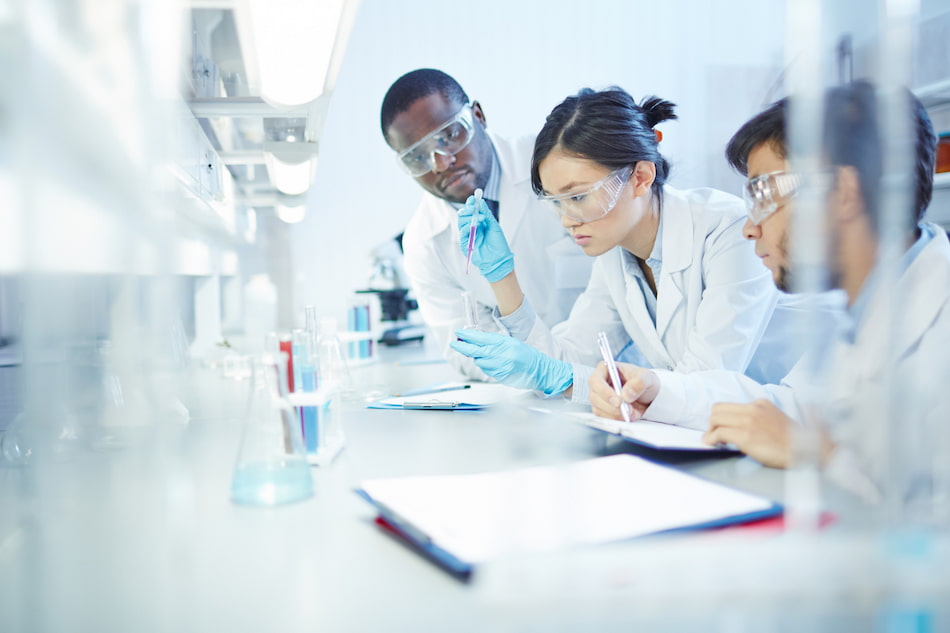Building a new company from the ground up is an intensive endeavor—and when it comes to start-up strategy in the biotech field, the intensity can grow thanks to the nature of the industry.
“There are basic processes that you have to do in order to get a business running and growing,” says Christa Dhimo, professor of the practice in Northeastern’s Master of Science in Biotechnology program. “In biotech, there are additional steps, functions, and processes with specific nuances.”
Those nuances include the need to balance business concerns like funding and profitability with the serious responsibility of developing safe, effective diagnostics and therapeutics that can receive FDA approval. A strong understanding of both science and business is essential for success within the biotech industry.
Download Our Free Guide to Advancing Your Biotechnology Career
Learn how to transform your career in an industry that’s transforming the world.
Understanding the Biotechnology Space
Business leaders within the biotech space keep several important factors in mind, Dhimo says, to ensure that their business produces safe, effective products while maintaining high levels of quality and compliance. Here are two top considerations she recommends prioritizing.
Respect for Life
People and animals are the recipients of medical biotechnology. Whether a company is working on diagnostics, therapeutics, or vaccines (therapeutic or prophylactic), the impact these products have on life should act as a guiding principle for the organization.
“In order to do well in this industry where the failure rates far exceed the success rates, you must have a depth of understanding and respect for life down to your core,” Dhimo says.
This is perhaps why so many remain in the industry despite the long timelines that accompany the rigorous research and development process. It can take an average of 12 to 15 years to successfully complete the transition from experimental drug to marketable product. Though the processes can appear slow—particularly from a traditional product development perspective—they’re essential in creating products that find diseases and treat patients rather than harm them.
Even the path to the latest technologies has evolved over a lengthy process of discovery, research and development. Dhimo points to gene therapy as one such example. After many decades of research, the FDA issued its first approval to bring gene therapy to the U.S. in August 2017.
“Meeting an unmet patient need is the purpose behind medical biotechnology,” Dhimo says. “There are times when a scientific discovery is incredible, and we clearly see how it might impact a patient’s life. Then we go through years of controlled studies so we can develop a product that will eventually meet the rigor required for clinical trials, the biggest one being a Phase 3 clinical trial. It is far easier to remain motivated throughout the years of development when we remember how we positively impact patients’ lives.”
Playing by the Rules
“There are a lot of very, very good rules associated with developing and launching a product,” Dhimo says. These rules ensure that biotechnology companies are following the highest standards of safety, accuracy, and efficacy in their studies and appropriately communicate information about an approved product.
While understanding the rules is important, Dhimo says it’s also important to consider that regulators have historically made adjustments when needed to keep pace with industry advancements and patient needs as best as possible. The FDA recently launched the Digital Health Center of Excellence to help facilitate the development and review of advances in technology associated with medicine.
“It might not always happen as fast as we would like, but it does happen,” Dhimo says.
For instance, the FDA cleared the Apple Watch as a Class II medical device, though the technology did not undergo the traditional clinical trial process. Similarly, the Orphan Drug Act created a pathway for researchers to study rare diseases under a different, but still rigorous, set of rules than more common conditions.
These exceptions to established rules were made with great care and research, underscoring the importance of thoroughly understanding regulations before stepping outside of them in extraordinary circumstances.
Unique Considerations Within Biotechnology
The biotechnology industry’s focus on safety and efficacy—both of which must be present in all products before they can be approved—sets the industry apart from others and creates unique considerations for business leaders.
“You can’t sell a product—you actually can’t even talk about it in a commercial setting—until it’s been approved to do so based on a very rigorous scientific method,” Dhimo says. “You don’t think about the tactics of marketing until you fully understand the safety and efficacy of the product, and you don’t really know the safety profile and efficacy until you start to ramp up what it might look like in the real world during a Phase 3 trial.”
This means that, in biotech, marketing executives aren’t solely concerned with selling products to patients—they’re also concerned with following highly regulated standards designed to protect and help patients. They must also do so alongside a medical affairs team, which oversees various medical aspects of the process, including how non-promotional medical information is provided. Many biotech companies employ a medical science liaison to assist. This person works with physicians, principal investigators, and businesspeople to support new products both toward the end of a clinical trial and during the first several years of product launch. The medical science liaison may be called on to explain the science behind a product, discuss the package insert or indication, and advise business leaders when it comes to the medical aspects of the product, among other duties.
Biotech Companies and Profitability
With so many regulations, considerations, and differences from other businesses, how does a biotechnology company remain profitable? As it turns out, most don’t—but that’s not a problem for experienced biotech investors.
Though it can take up to 15 years to fully develop and begin selling most biotech products, a company’s pipeline and technological assets can be worth billions based on the discovered science and its potential impact to patients. For example, Gilead Sciences purchased Kite Pharma—a company with a $600 million deficit—for nearly $12 billion in 2017. The price was based largely on Kite’s strong pipeline of CAR-T cell therapy for cancer treatments.
Venture capitalists and public market investors use cash flow projections, probability, and research about upcoming developments in the industry to value companies, then invest accordingly. They don’t expect a return on their investment right away, choosing instead to help fund the expensive drug development process in the hopes of a larger return later.
Investments have kept pace with the biotech industry’s ever-improving track record of scientific breakthroughs. The average venture capital investment in biotech companies more than doubled within 10 years, from $4.6 billion in 2005 to $12.9 billion in 2015.
Thanks to the wealth of research being conducted and shared, biotech companies have been able to shorten timelines while remaining dedicated to safety and compliance, which in turn may increase both profitability and funding.
“There’s enough existing data being shared to help enhance and accelerate some studies,” Dhimo says. “That doesn’t mean the process is not as rigorous just because you found some efficiency, but here is a great example of how the community is seeking ways to bring the best product to the right patients at the right time.”
Biotechnology at Northeastern
Northeastern University is home to numerous biotech labs, faculty with industry experience, and a comprehensive master’s in biotechnology program, which has been developed with the help of an industrial advisory board. This board is made up of well-known and experienced biotech and pharmaceutical professionals who can offer their expertise to help maintain a program that prepares graduates for biotech careers.
Rather than focusing primarily on research, Northeastern’s biotech degree is steeped in practical applications of biotech and professional skills. Students participate in a four- to six-month co-op experience that helps them put these skills into practice before they graduate.
Students interested in the business of biotech can select the enterprise concentration, which Dhimo leads, in the biotechnology program. Many faculty members in both programs are still directly involved in the biotech industry, helping to maintain the connection between real-world experience and the classroom. Dhimo credits the faculty’s perspective on biotechnology with encouraging students to think more creatively during their studies.
“We talk about the importance of being creative and wondrous and curious,” she says. “When you’re in science, it really is about discovery and valuing innovation.”
To learn more about careers in biotechnology, download our ebook at the link below.







Related Articles
Compliance Specialists: Who They Are and What They Earn
Science or Science Fiction? The Future of Personalized Medicine
In-Demand Biotechnology Careers Shaping Our Future